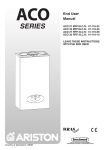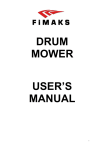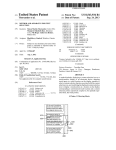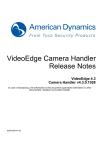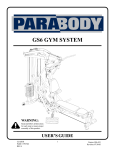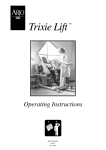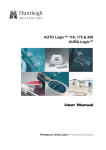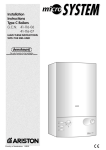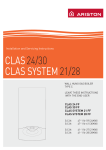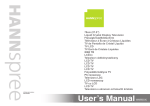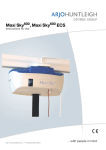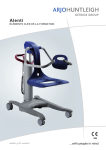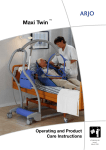Download Service Procedures - Livermore Scientific, Inc.
Transcript
MAXI MOVETM Maintenance and Repair Manual 001.25075.EN_rev0 July 2008 © ARJO International AB 2008 ARJO products are patented or patent pending. Patent information is available by contacting ARJO International AB. Our policy is one of continous development, and we therefore reserve the right to make technical alterations without notice. The content of this publication may not be copied either whole or in part without the consent of ARJO International AB. Table of Contents Safety Instructions ...........................................................................5 General .............................................................................................................. 5 Product and Technical Description ...............................................6 Introduction ....................................................................................................... 6 Features ............................................................................................................. 6 Combi Feature ................................................................................................... 6 Risk Assessment Checklist for Engineers ......................................................... 7 Suggested Tools ................................................................................................ 8 Recommended Spares ....................................................................................... 8 Loctite Application ............................................................................................ 9 Torque Data and Consumable Materials ........................................................... 10 Preventive Maintenance Schedule .................................................12 Service Procedures ..........................................................................17 Procedures not Included in the PMS ................................................................. 17 Service Procedure 1 ........................................................................................... 18 Check that the latest updates have been implemented ................................ 18 Service Procedure 2 ........................................................................................... 19 Check the battery ......................................................................................... 19 Battery test ................................................................................................... 19 Check the battery charger ............................................................................ 20 Service Procedure 3 ........................................................................................... 21 Check all vital parts for corrosion and damage ........................................... 21 Painting ........................................................................................................ 21 Service Procedure 4 ........................................................................................... 22 Full Feature Test .......................................................................................... 22 Service Procedure 5 ........................................................................................... 23 Safe Working Load Test (local Requirement) ............................................. 23 Service Procedure 6 ........................................................................................... 26 Scale Calibration Check .............................................................................. 26 Verified Scale ........................................................................................ 26 Verified Scale and Non-Verified Scale ................................................. 26 Service Procedure 7 ........................................................................................... 27 Wheel Replacement ..................................................................................... 27 Front ...................................................................................................... 27 Back ....................................................................................................... 28 Service Procedure 8 ........................................................................................... 29 Changing the Leg Assembly/Actuator ........................................................ 29 Chassis opening ..................................................................................... 29 Legs ........................................................................................................ 29 Legs Actuator ......................................................................................... 29 Reassembly ............................................................................................ 30 Service procedure 9 ........................................................................................... 31 Legs opening adjustment ............................................................................. 31 Verification ............................................................................................ 31 Adjustment ............................................................................................. 31 Service Procedure 10 ......................................................................................... 32 Control box (PCB, Fuse, Switch, Keypad) .................................................. 32 Opening the Control box ........................................................................ 32 Fuse change ............................................................................................ 32 Main board changes ............................................................................... 32 DIP Switch Settings ..................................................................................... 34 Configuration procedure ........................................................................ 34 Changing the Brake board ..................................................................... 36 3 Table of Contents Changing the Switch ............................................................................. 36 Closing the control box .......................................................................... 37 Service Procedure 11 ......................................................................................... 39 Replacing the Handset ................................................................................. 39 Service Procedure 12 ......................................................................................... 40 Replacing the Maxi Move Strap .................................................................. 40 Strap removal ......................................................................................... 41 Top Cover reassembly ........................................................................... 44 Verification ............................................................................................ 45 Service Procedure 13 ......................................................................................... 46 Replacing the Mast Actuator ....................................................................... 46 Removing the Mast ............................................................................... 46 Removing the Actuator .......................................................................... 47 Installing the Mast ................................................................................. 48 Service Procedure 14 ......................................................................................... 49 Replacing/Adjusting the Handle .................................................................. 49 Removing the Handle ............................................................................ 49 Replacement ........................................................................................... 50 Adjustment ............................................................................................. 50 Service Procedure 15 ......................................................................................... 51 Changing the Limit Switch .......................................................................... 51 Anti-crush / Lower Limit ....................................................................... 51 Upper limit ............................................................................................. 52 Service Procedure 16 ......................................................................................... 54 Slider Adjustment Replacement .................................................................. 54 Adjusting Sliders .................................................................................... 54 Upper slider ........................................................................................... 54 Lower slide ............................................................................................ 55 Replacing Sliders ......................................................................................... 55 Service Procedure 17 ......................................................................................... 56 Jib / Jib roller / Jib cover ............................................................................. 56 Jib removal ............................................................................................. 56 Jib Reinstallation .................................................................................... 56 Jib roller change ..................................................................................... 56 Changing the Jib Top Cover .................................................................. 57 Service Procedure 18 ......................................................................................... 58 Combi Attachment ....................................................................................... 58 Inspection ............................................................................................... 58 T-Bar removal ........................................................................................ 59 T-Bar installation ................................................................................... 59 Service Procedure 19 6....................................................................................... 0 Scale Removal/Installation .......................................................................... 60 Removing the Scale ............................................................................... 61 Installing the Scale ................................................................................. 61 Service Procedure 20 ......................................................................................... 62 Combi Spreader Bars ................................................................................... 62 Stretcher ................................................................................................. 62 Four-Point DPS Pivot Point ................................................................... 63 Four Point DPS (Combi) ............................................................................. 63 Four-Point Powered DPS Spreader Bar ...................................................... 64 Sling Checks ................................................................................................ 66 4 Safety Instructions General A. ARJO strongly advise that only ARJO designated parts, which are designed for the purpose, should be used on equipment and other ARJO supplied appliances to avoid injuries attributable to the use of inadequate parts. ARJO’s conditions of sale make specific provision confirming no liability in such circumstances. Our policy is one of continuous development, and we therefore reserve the right to change specifications without notice. B. Unauthorized modifications on any ARJO equipment may affect its safety and are in breach of any warranty on it. ARJO will not be held responsible for any accidents, incidents or lack of performance that occur as a result of unauthorized modifications to its products. C. If the terms listed below are used in the text their meaning is as follows: DANGER Means: Electrical hazard warning, failure to understand and obey may result in electrical shock. WARNING Means: Failure to understand and obey may result in injury to you or to others. CAUTION Means: Failure to follow these instructions may cause damage to all or parts of the system or equipment. NOTE Means: This is important for the correct use of this system or equipment. D. Dangerous substances. If using hazardous substances be sure how to handle these and refer to applicable information. In doubt refer to the local authorities for health and safety requirements. 5 Product and Technical Description Introduction The Maxi Move is a mobile patient lifter and is used for transferring patients from bed or chair to the toilet or bath. The floor lift has a maximum safe working load (SWL) of 227 kg (500 lb). NOTE: The SWL will depend on the lift’s configuration and attachments. Always refer to the maximum SWL of the lowest rated attachment. Each Maxi Move is supplied with two 24V rechargeable batteries and a charging unit. Features The features of the Maxi Move floor lift include: • Immediate stop/reset switch • Overload circuit • Overload current limit protection in the PCB • Upper limit switch • Lower limit switch/anti-crush • Control panel on the unit • Emergency manual wind down • Handset LCD display • Audible low-battery warning The raising and lowering mechanism comprises an electromechanical linear actuator powered by a 24VDC motor. The leg opening and closing mechanism comprises a 24VDC motor and a double-ended actuator (legs open independently). Combi Feature The Maxi Move with the ‘Lock & Load’ (combi attachment) has the facility to accommodate: • A two-point spreader bar for use with a loop sling to support patients with contracted (restricted movement) or ‘windswept’ (deformed) limbs and walking slings. • A two-point loop small. • A two-point loop medium. • A four-point loop large. • A four-point spreader bar Dynamic Positioning System (DPS) for general lifting (small, medium and large). • A 4 point powered spreader bar Dynamic Positioning System (DPS) for general lifting (medium and large). • A stretcher system for handling dependent, fragile patients with a minimum of disturbance (SWL 160kg (350 lb)). 6 Product and Technical Description Risk Assessment Checklist for Engineers WARNING: IF IN DOUBT, CONTACT YOUR LOCAL ARJO REPRESENTATIVE. DO NOT TAKE UNNECESSARY RISKS. The following assessment MUST be made before carrying out servicing, repair work or installations: • Make sure the work area is adequately sized, suitably lit and at a reasonable temperature. • The floor surfaces must be free from clutter, unevenness and non-slip. • Use good engineering and manual handling practices to keep risk of injury at its lowest level. • Tools and equipment must be kept in good condition. • Wear protective clothing and eye protection where necessary. • You should be adequately trained to perform the task. • Do not manually lift items that could cause personal injury, that is too heavy, hot or sharp. • You must comply with all local site safety rules, report any incident or accident to the site safety supervisor or equivalent. Use the ARJO reporting procedure. • If necessary use Hard Surface Wipes (Alcohol Impregnated) to decontaminate a machine before carrying out any work. NOTE: The above wipes should be of the type that has proven bactericidal action for disinfecting hard surfaces against MRSA & E.COLI. • Load tests must only be applied as instructed in the relevant procedure. • If it is necessary to work from a platform (i.e. scaffold, ladders etc.) to perform a service or installation task make sure the platform is secure and suitable for the task. DANGER – Electrical Shock can kill. • Do not perform maintenance tasks on equipment with ‘live’ electrical connections unless absolutely necessary. • Isolate the power supply before removing plugs, sockets or disconnecting cables. • Be alert at all times to the dangers of working on electrical equipment that operates on mains supply voltage. Where possible, visually inspect electrical cables and plugs etc. for damage or deterioration before working on equipment. • Dispose of all waste in appropriate containers. 7 Product and Technical Description Suggested Tools • Standard tool kit. • Special Tool ST252. • 2 x 20kg weights ST219. • Socket Allen key: (4mm ST82) (5mm ST274) (6mm ST55) (8mm ST87). • Drift ST288. • Ball-end Allen key (4mm) ST292. • Starlock Washer Installation Tool (ST295). • Sling Clip Gauge ST331. • Load Test Equipment: refer to Section 11.0. Recommended Spares Refer to PARTS LIST 001.25070.EN NOTE: This manual is intended to be used in reference to the Maxi Move manufactured in Canada (Serial number KMCXXXXX). For the Maxi Move manufactured in the UK or in Sweden, please refer to: 09.MKM.00/3GB 8 Product and Technical Description Loctite Application Refer to the manufacturer instructions on the container before use, in addition to the following information: Procedure for the correct use of Loctite 242 and Loctite 243 (Colour blue) Threadlocking: - Clean both of the joint faces with Loctite 7063 Cleaner or a lint-free cloth moistened with Acetone or another suitable volatile solvent. NOTE: Because Loctite 243 is oil-tolerant, it is not necessary to meet the same standard of oil-free cleanliness as for Loctite 242. - Apply Loctite 243 sparingly but sufficient to fill all engaged threads. (This product performs best in thin bond gaps [0.05 mm]). - Install the threaded components and where known, torque to the applicable torque figure. If the torque figure is not known tighten to a firm fixing. - Clean off any unwanted adhesive. - Allow the Loctite 243 to cure before subjecting to load. NOTE: The cure time will depend on the materials used, the ambient temperature and the bond line gap. - Where the cure speed is unacceptably long, or large gaps are present, applying Loctite Activator ‘N’ or ‘T’ to the surface will improve the cure speed. For general Loctite specifications and application details: refer to Loctite manufactures instructions. 9 Product and Technical Description Torque Data and Consumable Materials Thread retaining: Apply Loctite 243 when no threadlocking patch has been pre-applied. When replacing a part with pre-applied threadlocking, the part should be replaced by a new part using pre-applied threadlocking. NOTE: Grease 005.00031: Lenson white grease or equivalent can be used. Fig.1 10 Product and Technical Description Fig.2 11 Preventive Maintenance Schedule Visually inspect the condition of all sling attachment points for damage. If any is found, replace with new unit. X X X X Make sure all instruction labels are attached and readable. Replace as required. See “Operating Instructions” for location of labels. X X X X Check the condition of the friction discs and bushes within the pivot points. If found worn and/or damaged, parts must be replaced. S S When the friction discs and bushes have been checked/replaced, reset friction assembly to support a 5.4 kg (12 1b) load at the handle. S S Visually inspect all external parts, making sure no damage has occurred during use. Replace parts as required. S S Make sure the unit can be powered through the full range smoothly. Examine all exposed parts, especially where there is close contact with the patient’s body. Make sure no cracks or sharp edges have developed that could cause injuries or become unhygienic. Replace where necessary. KEY: S X S X = Action required on the part of the customer X S X S S = Action required on the part of a qualified service technician 12 X S Every 2 Years Every 12 Months Before Every Use Stretcher Every 2 Years Every 12 Months Every Week Before Every Use 2-4 Point Every 2 Years Every 12 Months Every Week Before Every Use Powered Every 2 Years Every 12 Months Every Week Action Before Every Use Manual Loop Spreader Bars Every Week DPS Spreader Bars Preventive Maintenance Schedule X X X X X X X X Accessories X Examine for damage/fraying to sling, straps and clips; replace as required. Visually examine the battery charger for loose connectors, cut wires, damaged casing etc. Do not use if damaged in any way. Before Every Use Battery Charger Every 2 Years Every 12 Months Every Week Before Every Use Every 2 Years Every 12 Months Every Week Action Before Every Use Slings X = Action required on the part of the customer Every 2 Years S Maxi Move KEY: Every 12 Months Before Every Use Every 2 Years Every 12 Months Every Week Before Every Use Every 2 Years Every 12 Months Every Week Before Every Use Every 2 Years Stretcher S X S = Action required on the part of a qualified service technician 13 S Every 2 Years Visually inspect to make sure the leaf spring within the locking clip is correctly installed. X 2-4 Point Every 12 Months Visually inspect that the spreader bar correctly installs on the jib, i.e. that the plastic clip latches into the groove on the “T” part on the jib. Powered Every Week Inspect the condition of the leaf spring and locking clip at the attachment point. Replace if damaged. Every 12 Months Action Every Week Before Every Use Manual Loop Spreader Bars Every Week DPS Spreader Bars Preventive Maintenance Schedule Accessories X Operate the lift through its full range from both the control panel and the control handset in a normal and smooth manner. X With the jib in the fully lowered position, visually examine the exposed lifting straps on each side of the mast for any cuts or fraying. If damaged in any way, withdraw lifter from use immediately and have lift straps replaced with new ones. X Open and close the chassis legs and check for full range of motion and smooth movement. X Visually check the condition of the handset and its cable. If damaged, withdraw from service immediately and replace with new cable and handset assembly. X Visually check that all external fittings are secure, and all screws and nuts are tight. X Make sure all castors rotate freely and that the two rear brakes lock. Replace as required. X Make sure all castor-mounting pins are tight on the chassis and chassis legs, and that the castor tread is not damaged. Replace as required. X Make sure all instruction labels are firmly attached and readable. Replace as required. See “Operating Instructions” for location of labels. X X = Action required on the part of the customer S S = Action required on the part of a qualified service technician 14 X Every 2 Years Every 12 Months Every Week Every 2 Years Every 12 Months Every Week Before Every Use Battery Charger S Recharge battery for a minimum of 15 hours once every seven days. See “Operating Instruction’s” for battery charging procedure. KEY: Every 2 Years X Every 12 Months Make sure the battery is in a good state of charge. See “Operating Instructions” for the battery charging procedure. Every Week Action Before Every Use Slings Before Every Use Maxi Move Preventive Maintenance Schedule Accessories Examine all exposed parts, especially where there is close contact with the patient’s body. Make sure no cracks or sharp edges have developed that could cause injuries or become unhygienic. Replace where necessary. S Test the “Immediate Stop” facility. S Mechanically test the “System Failure Wind Down” facility. S Where a scale is installed, check the accuracy of the unit and recalibrate if required. S Examine the two lifting straps over the entire length. Replace the straps if there is evidence of wear or damage. S Perform a torque tightening check. S Check the 2.5 kg force required to rotate the jib pivot. Adjust screw if required. S Check the gap between the “T” piece flange and jib. If more than 2 mm, replace jib bushes (minimum gap is 1 mm). S Verify the width of the legs. First, remove the leg covers. With the legs closed, measure centre to centre at the ends near the front castors. Adjust only if dimension “A” is shorter than 650 mm (25 1/2”). S X = Action required on the part of the customer S = Action required on the part of a qualified service technician 15 Every 2 Years Every 12 Months Every Week Every 2 Years Every 12 Months Every Week Before Every Use Battery Charger X Test the “Automatic Cut-out” function. KEY: Every 2 Years Every 12 Months Every Week Action Before Every Use Slings Before Every Use Maxi Move Preventive Maintenance Schedule Accessories It is recommended to replace the two lift straps every 2 years if they are used. If the straps appear damaged or worn before then, replace the straps immediately. Lubricate the two top strap rollers. S Check and lubricate the upper and lower mast sliders. Replace if worn or damaged. If necessary, adjust to remove excessive gap in the column. S Check and replace as necessary the 4 off jib rollers and 2 off guide blocks if they show signs of wear or damage. S Check the combi “T” piece and attachment contacts if fitted. Clean and replace as required. S X = Action required on the part of the customer S = Action required on the part of a qualified service technician 16 Every 2 Years Every 12 Months Every Week Every 2 Years Every 12 Months Every Week Battery Charger S Check the Usage Counter and reset if required. KEY: Before Every Use Every 2 Years Every 12 Months Every Week Action Before Every Use Slings Before Every Use Maxi Move Service Procedures Procedures not Included in the PMS Jib/Jib roller- SP 17 Limit switch replacement- SP 15 Scale calibration- SP 6 Scale - SP 19 Strap replacement- SP 12 Combi T-bar attachment- SP 18 Combi spreader bars- SP20 Handset replacement- SP 11 Handle replacement- SP 14 Mast slider replacement- SP 16 Control box- SP 10 Mast actuator replacement- SP13 Leg opening adjustmentSP 9 Battery and charger-SP 2 Wheel replacementSP 7 Leg actuator replacementSP 8 Fig.3 17 Service Procedures Service Procedure 1 Check that the latest updates have been implemented • Check if there are any field correction bulletins, safety notices or technical bulletins that have been published since the last service. (These replace the previously used Technical Advice Notices (TAN) with status A (i.e. safety issue, requiring some form of recall) or B (non-safety issue). • This verification must be done to keep the product up to date according to safety and product improvements. Bulletins and notices can be generated as a result of an engineering change note, a safety incident report or a change to form/fit etc. Example of a Technical Bulletin Fig.4 18 Service Procedures Service Procedure 2 Check the battery The battery power tester will load the battery with a high current (up to 60 A, depending on battery condition) for a short time and this will show the battery condition on a meter. WARNING! • The battery power tester will become hot and there is a potential risk of fire. • Make sure the battery power tester is kept away from inflammable material during tests and for several minutes following the test. • Beware of touching the metal casing for several minutes following the test. Battery test 1) The battery to be tested must be charged for at least 12 hours before test. 2) Connect the tester to the battery. DO NOT operate the test switch! When the tester is connected, switch the test switch right or left for 1-2 seconds and take a quick reading on the meter. 3) The meter will show the battery’s condition. 4) If the battery is OK, place the tested battery back in the charger. Battery tester Fig.5 19 Service Procedures Check the battery charger 700.24250 1) Connect the cable from the test rig to the charger. • Measure the voltage in the banana plug outlet of the rig. The voltage should be between 27.6 and 28 VDC. 2) Measure the current in the banana plug outlet of the rig. • Turn the knob until the amber led indicator starts blinking. • The current should now be between 0.9 and 1.1A. Battery charger Fig.6 20 Service Procedures Service Procedure 3 Check all vital parts for corrosion and damage This verification will help preserve the safety and performance of the product. To Verify: 1) Front caster 2) Legs 4) Chassis 15 13 9 15 5) Column 14 6) Battery 7) Control box 10 11 12 3) Braked caster 8 16 8) Handle 9) Handset 7 10) Strap 6 11) Jib 12) T-bar jib attachment 5 13) T-bar 4 14) DPS 15) DPS actuator 16) Clip attachment 3 2 1 Fig.7 Painting If the paint is damaged (scratches/marks), add paint in matching color to prevent further corrosion. NOTE: Before applying the paint the surface must be clean and dry. 21 Service Procedures Service Procedure 4 Full Feature Test Function Activation/ Validation Lift up/down Buttons Legs open/ close Buttons DPS Sit/Recline Buttons Rotation and swiveling of casters Manual Braked caster Manual Handset Buttons Touchpad Emergency lowering devices Buttons Manual Actions Criteria for approval No abnormal noises; unit reaches up/ down points as per specifications (see user manual) No abnormal noises; legs open fully Full opening and closing on each side (see user manual) No abnormal noises; DPS moves Full stroke of DPS freely Full stroke up and down Move on short distance, rotating the lifter No pulling, no abnormal noises or vibrations Engage the brake on each rear caster Press each button, check display Press each button Use emergency lowering devices (see user manual) Easy engagement/disengagement; lift immobile when brakes are engaged All lift functions working; no display issues All functions working normally 22 Jib must lower as per user manual Service Procedures Service Procedure 5 Safe Working Load Test (local Requirement) WARNING: OBEY ALL RELEVANT SAFETY PRECAUTIONS. 1. Medium Powered and Non-Powered Dynamic Positioning System (DPS) • Set up the ARJO Load Test Kit as shown and test to the Safe Working Load (SWL). • Release the load and remove the load test equipment. Check the hoist for any permanent deformation or damage. 2. Loop Medium Two-Hook and Walking Jacket Two-Hook • Set up the ARJO Load Test Kit as shown and test to Safe Working Load (SWL). • Release the load and remove the load test equipment. Check the hoist for any permanent deformation or damage. Jacket Two Hook (not illustrated) Medium Powered and Non-Powered DPS Tool No. ST164 Description Qty Tool No. 1 ST164 2 ST165 2 ST166 Hinge Beam 1 ST239 Handset and Load Cell Load Test Strap (short) Load Test Strap (long) Hinge Beam Hook Bolt 1 ST240 Hook Bolt 1 Plunger Bracket 1 ST241 Load Cell Housing 1 ST171 Handset and Load Cell Load Test Strap (short) Load Test Strap ST239 ST240 ST243 ST165 Medium Loop and Two-Hook Walking Jacket (not illustrated) Fig.8 23 Description Qty 1 2 2 1 Service Procedures 3. Loop Small Two-Hook • Set up the ARJO Load Test Kit as shown and test to Safe Working Load (SWL). • Release the load and remove the load test equipment. Check the hoist for any permanent deformation or damage. 4. Loop Large Four Hook • Set up the ARJO Load Test Kit as shown and test to Safe Working Load (SWL). • Release the load and remove the load test equipment. Check the hoist for any permanent deformation or damage. Small Loop Tool No. ST164 ST165 Large Four-Hook Loop Qty Tool No. Handset and Load Cell Load Test Strap (short) Description 1 ST164 2 ST165 Hinge Beam 1 ST239 ST166 ST239 Description Handset and Load Cell Load Test Strap (short) Load Test Strap (long) Hinge Beam Qty 1 2 2 1 ST240 Hook Bolt 1 ST240 Hook Bolt 1 ST241 Load Cell Housing 1 ST241 Load Cell Housing 1 Fig.9 24 Service Procedures 5. Large Powered and Non-Powered Dynamic Positioning System (DPS) • Set up the ARJO Load Test Kit as shown and test to Safe Working Load (SWL). • Release the load and remove the load test equipment. Check the hoist for any permanent deformation or damage. 6. Combi Stretcher Frame and Strap Stretcher • Set up the ARJO Load Test Kit as shown and fill the 6 x 25 liter water containers (part of ST120) with water and test to 160kg. NOTE: The six water containers filled with water equal the SWL of 160kg. • Maintain the load for a period of 5 minutes. During this period move the containers to ensure that all cross straps are tested. • Remove the containers and visually check the strap stretcher and associated details for any signs of deterioration. We recommend replacing any defective parts. • Record the frame’s condition and any recommendations on service paperwork and obtain the customer signature. • Affix the completed ARJO adhesive service label to the hoist and leave a copy of the paperwork, including the load test certificate, with the customer. Large Powered and Non-Powered DPS Tool No. Qty Tool No. Description Qty ST40 Load Frame & Straps 1 ST120 Water Barrel 6 ST164 1 ST239 Handset and Load Cell Load Test Strap (short) Hinge Beam ST240 Hook Bolt 1 ST241 Load Cell Housing 1 ST165 Description Combi Stretcher Frame and Strap Stretcher 2 1 Fig.10 25 Service Procedures Service Procedure 6 Scale Calibration Check Verified Scale Official scale calibration verification or re-verification should be take care by an approved organization in accordance with the standards stipulated by local authorities (as specified by each country). If a calibration is necessary on a verified scale, the new calibration will break the verification seals and will require a new verification by an approved organisation. Verified Scale and Non-Verified Scale If your test weights require hooks or chains, place them on the scale before powering up the lifter. The scale will automatically zero itself at start-up. Lift your test weights with the hooks or chains. While in service calibration, the tolerance for a weight “m” is: 2 kg < m 50 kg: ± 0.1 kg 50 kg < m 200 kg: ± 0.2 kg 200 kg < m 227 kg: ± 0.3 kg If any results are measured to be out of those tolerances, the scale should be disqualified and be re-calibrated. Contact your manufacturer for more details. 26 Service Procedures Service Procedure 7 Wheel Replacement NOTE: KMCS** model needs 100 mm front casters and KMCL** model needs 86 mm casters. Front 1) Place the Maxi Move on its handles, with the legs pointing upward. 2) Remove the bolt that holds the caster assembly using an 8 mm Allen key. The wheel of the caster cannot be dismantled. The caster must be changed. 3) Before installing the caster, check the integrity of the aluminum thread in the leg tip. If worn, do not reinstall the caster and change the legs. Install the new caster by using the new bolt that came with the caster. Do not overtighten the bolt! NOTE: Carefully place the caster component in the correct order (see picture) Caster Top cap M10 Bolt Top sleeve M10 flat washer Fig.11 4) Check that the caster spins freely over the bolt. 27 Service Procedures Back 1) Place the Maxi Move on its handles, the legs pointing upward 2) Remove the self-locking nut under the caster using a 13 mm socket and pull back the caster 3) Reinstall the caster. NOTE: Carefully place the caster components in the correct order (see Fig.11). The self-locking nut can be reused. Check that the caster spins freely over the studs and that the break mechanism is working properly. Fig.12 28 Service Procedures Service Procedure 8 Changing the Leg Assembly/Actuator Chassis opening 1) Slightly open the legs of the Maxi Move, to remove the pressure over the mechanical stop in the chassis. Failure to do so will prevent the base from opening. 2) Place the Maxi Move on its handles. Place an object under the battery holder to raise the chassis, so that no part of the chassis touches the ground. 3) Remove all the bolts located under the chassis. 4) Pull on the chassis lower part and carefully pull it out. Legs 1) Detach the safety clips that retain the pin in the leg and the actuator. Be careful that neither the legs nor the actuator falls sideways, since they are no longer secured. 2) Carefully pull out the legs from the pivot. 3) Install the caster (see SP 7) over the new legs. Install the adjustment nut and the self-locking nut as well. 4) Inspect the pivot assembly and the actuator pin. If you spot signs of excessive wear, replace them for new ones. The dowel pin over the pivot fits inside the hole of the chassis. 5) Carefully put back the new legs over the pivot pins. Attach the actuator and the legs with the corresponding pins. Put back the safety clip. Legs Actuator 1) Remove the two clips and the two pins that retain the actuator. CAUTION: The legs will fall sideways when they are disconnected from the actuator. 2) Unplug the actuator and plug in the new actuator 3) While holding the actuator in place, replace the pin and the clip onto the new actuator. NOTE: the actuator must be in the oriented correctly (see picture). 29 Service Procedures Fig.13 Reassembly 1) Reinstall the cover and the nut. You may need to adjust the legs slightly to be able to slide the cover back on. NOTE: The 40 mm (1 1/2”) bolt must be used for the mast link attachment. DO NOT over- torque. Check that the cover fits without any gaps over the upper chassis. 2) Leg opening must be verified/adjusted after the installation. Refer to SP 9. 3) Following the installation, move the lift forward and backward to verify that the unit travels freely without a tendency to pull to the side. 4) Fully open and close the legs. The legs must move freely. 5) Perform a safe working load (SWL) test. See SP 5 (Local requirement). 30 Service Procedures Service procedure 9 Legs opening adjustment Verification 1) Close the legs using the button located on the control panel. 2) Place the Maxi Move on its handle. 3) Measure the distance according to Fig.14. If the dimensions are out of tolerance, the legs must be adjusted. Adjustment 1) Remove the two caps under the chassis with a flat screwdriver 2) Loosen the locknut. Turn the setscrew to adjust the legs to the correct dimensions. It might be necessary to open or close the legs to remove pressure on the setscrew during the adjustment (clockwise turn=closing legs, counterclockwise turn=opening legs). 3) Replace the caps under the base. Use Loctite instant adhesives to fasten the cap. Fig.14 31 Service Procedures Service Procedure 10 Control box (PCB, Fuse, Switch, Keypad) Changing the PCB or the fuse in the fuse holder requires that the control box be opened. Opening the Control box 1) Remove the battery 2) Remove the control box cover’s 4 Torx screws. 3) Lift the control box up approx. 10 mm (3/8”) vertically to disengage it from the clip holding it to the mast. 4) Carefully lower the control box. Fuse change Locate the fuse holder and open it by simultaneously pushing and twisting the two parts. If the fuse is blown, replace it by an equivalent 15 A fuse (UL or CSA approved). Main board changes NOTE: Use appropriate ESD protection when manipulating the PCB. NOTE: The clear plastic that protects the PCB is for the IPX4 water protection. DO NOT REMOVE IT. You can secure it with an elastic band to get access to the PCB. Also, do not remove the screw on the upper part of the control tower. There is a silicone seal between the two parts. If the parts should be separated, a new silicone seal must be applied (see attached picture). 1) Unplug all connectors going to the PCB. 2) Remove the 4 screws that secure the PCB. Remove the PCB. 3) Replace with a new PCB. Plug in all connectors. Ensure that the connector polarity is respected. 4) Replace the 4 screws that secure the PCB. DO NOT over-torque the screw, this may damage the PCB. 32 Service Procedures Main PCB Fig.15 Inside view of the control box Fig.16 33 Service Procedures DIP Switch Settings The 492.00066 PCBA is, by default, configured in a safe state that limits the operation of the hoist. However, the 492.00066 can be configured by positioning a set of on-board DIP switches. The DIP switches use a binary configuration scheme. The procedure in this document shows how to properly set the switches according to the hoist in which the circuit is to be installed. NOTE: This procedure does not cover any safety testing that must be performed after the installation of the PCBA into the hoist. Configuration procedure 1) Identify the PCBA assembly based on model number 492.00066-XX, where XX identifies the specific assembly. 2) Locate switch SW1 on the TOP side of the PCBA (see Fig.17). SW1 Fig.17 3) Position the switches according to the PCBA part number in Fig.18. 34 Service Procedures PCBA CONFIGURATION TABLE PCBA Assembly Part Number PCBA Description Switch Position (visual) Switch Position Number 492.00066-01 PCBA IMF Maxi Move STANDARD JIB 01 492.00066-02 PCBA IMF Maxi Move EXTENDED JIB 02 492.00066-33 PCBA IMF Maxi Move EUROPEAN STANDARD JIB 03 492.00066-34 PCBA IMF Maxi Move EUROPEAN EXTENDED JIB 04 Fig.18 4) Tests must be performed to verify that the correct DIP switch selection has been made. Either one of the following methods will suffice: • Connect an LCD hand control unit (Part #700.13700) to the 492.00066.XX PCBA. At power up, the LCD hand control screen will display the existing DIP switch configuration. Refer to the table in Fig. 2 to make sure that the displayed setting is correct. • Conduct a visual inspection of the DIP switches to make sure that the switches were positioned properly according to the PCBA part number. 5) Apply glue or a tamper proof sticker on the DIP switches to preserve the configuration and identify the PCBA assembly accordingly. 35 Service Procedures Changing the Brake board 1) Remove main PCB (see above). 2) Disconnect all connectors to the brake board. 3) The PCB is attached with double side tape. Remove it by pulling on it. 4) Take the new PCB and pull back the liner on the double side tape. 5) Attach the PCB on the bottom off the control tower. Reconnect all the wires. 6) Reinstall the main pcb. Brake board Fig.19 Changing the Switch 1) Unplug the switch connector. 2) Pry the tab behind the switch and pull it out of the control box 3) Insert the new switch in place. 4) Pry the plastic tabs on the side of the switch to hold it in place 5) Connect the wires back to the switch 6) Fix the bezel over the switch with Loctite instant adhesive. The higher side of the bezel must be over the green button of the switch. 36 Service Procedures Closing the control box (See Fig.20, on next page) 1) Place the clear plastic film carefully over the board. 2) Insert the base of the control box inside the battery bucket 3) Carefully place the wires. Be sure to not pinch the wire behind a screw or on the edge of the control box. 4) Push the control box over the backplate. 5) The two-prong on the control box locks into the slot on the handle. Once the control box is well fitted over the backplate, slide it down completely (approx. 10 mm [3/8”]). 6) Check that the gap between the control box and the backplate is consistently small. A bigger gap means that some wires are pinched behind the control box. 7) Replace the the 4 Torx screws. 8) Put back the battery, turn on the Maxi Move and perform a functional test (see SP 4) 37 Service Procedures Fig.20 38 Service Procedures Service Procedure 11 Replacing the Handset 1) Remove the battery 2) Using a small flat screwdriver or similar tool, open the handset door by prying on the tabs. 3) Slide the handset cable’s grommet from the control box. 4) Use the flat screwdriver to press on the the telephone jack’s release tab located on the handset cable inside the control box. Pull out the connector. 5) Plug the new handset and attach the grommet inside the slot on the control tower. 6) Replace the door of the handle. Be sure the door locks back in place 7) Put back the battery, turn on the lift and perform a functional test (SP 4). Fig.21 39 Service Procedures Service Procedure 12 Replacing the Maxi Move Strap Fig.22 40 Service Procedures Strap removal 1) Lower the Maxi Move until the the lower limit switch is activated. 2) Remove the screw in the back of the cover cap. Pull out the emergency lowering pin. 3) Remove the top cap by lifting it from the front. Some force may be necessary to remove it. 4) Remove the wire protecting cap. 5) Cover the handles to protect them, and place the Maxi Move down on the floor. 6) Remove the strap roller and the pivot pin on both sides. 7) Carefully pull out the jib, in order to see the the strap attachment points on the jib. DO NOT PINCH THE FLEXIBLE WIRE. See Fig.23 and Fig.24 that show how to pass the wire in order to protect it. Place loop of wire inside the extrusion Fig.23 41 Service Procedures Fig.24 8) Remove the starlock washer on the jib pin. Remove the strap. For the strap with a wire clipped inside, carefully remove the wire from the clip. 9) Take the two new straps and compare strap lengths. ALWAYS PUT THE SHORTEST STRAP ON THE SIDE OF THE WIRE. Position the plastic washer, then the strap over the jib pin, and finally the starlock washer (use a box socket to fasten the starlock washer). The X on the strap clip must be facing toward the column. Fig.25 42 Service Procedures 10) Slowly turn the top of the actuator until you can see the strap pivot across the hole on the front of the column. 11) Insert a M4 screw inside the pin and carefully pull out the pin. It might be necessary to lift the spring wire in the inner casting to relieve some pressure on the pin. 12) Take the other end of the new strap and position it between the posts of the inner top casting. Push back the pin until it the spring wire clips into the groove on the pin. 13) Check the wear of the strap rollers. Replace them if needed. Grease the pivot pins and reinstall them with the roller. The pin must fit over the slot. 14) CAREFULLY lower the jib and guide the flexible wire to be sure it doesn’t get pinched by the jib. Fig.26 15) Reposition the lift on its 4 casters. Slowly raise the jib until your hear the ‘clicking’ noise of the limit switch. Release the jib slowly; the limit switch should disengage. 16) Raise and lower the column throughout its full stroke and check for any issues (noise, vibration, incorrect assembly). Fig.27 43 Service Procedures Top Cover reassembly Fig.28 1) Turn the ribbed wheel at the top of the actuator to align the hole in the actuator with the hole in the top casting outer mast. Slide the pin inside the hole to keep it in position. 2) Position the emergency handle assembly over the ribbed wheel so the handle lines up with the back of the column. Temporarily remove the pin, replace the wire protector and slide the cover back in place. Replace the pin and check if the emergency handle sits properly inside the top cover. Secure the pin lanyard with the screw in the top cover. DO NOT over torque. 44 Service Procedures Fig.29 Fig.30 Verification Once the cover is installed, raise and lower the column throughout its full stoke and check for any issues (noise, vibration, incorrect assembly). Perform a safe working load test (see SP 5 [local requirement]) and check the up/down function of the column. 45 Service Procedures Service Procedure 13 Replacing the Mast Actuator Fig.31 Removing the Mast 1) Raise the column enough to see the actuator screw head in the inner mast. 2) Remove the control box (see SP. 10) and the top plastic cap. 3) Remove the four screws that secure the battery bucket to the backplate and the two screws that holds the backplate to the chassis. 4) Raise the handle approx. 100 mm (4”) to get access to the mast’s two bolts. 5) Disconnect all the wires located at the bottom of the mast. 6) Remove the two bolts at the bottom of the mast. The bolts are held in with thread locker, so they might be hard to remove. Discard bolts once they’re removed. 7) Prepare an area to place the mast onto. Put back the emergency lowering pin. Lift the mast by holding the outer and inner masts. DO NOT RAISE IT BY THE JIB. 46 Service Procedures Removing the Actuator 1) Pull out the emergency lowering pin and remove the screw that holds the ribbed wheel in the actuator. 2) Remove the two screws that secure the actuator. These screws are held in with theadlocker, so be careful not to strip the heads. 3) Push on the actuator rod located near the top of the mast, and remove it. 4) Wrap the plastic over the actuator wire. Grease the top of the actuator and the two o-rings, and install plastic bearings on the top of the actuator. 5) Align the actuator wire with the channel of the inner mast. Slowly push the actuator to align it with the hole in the inner mast. Be sure that the top of the actuator fits into the hole in the top casting outer mast. Fig.32 6) Use NEW screw to secure the actuator. 7) Replace the ribbed wheel at the top of the actuator and replace the screw. DO NOT over torque. 8) Reinstall top cover (see SP12) 47 Service Procedures Installing the Mast 1) Secure the wires on the column to make sure that no wires get pinched between the mast and the chassis. 2) Replace the mast over the chassis. Check wire positions before completely lowering the mast to the chassis. 3) Use NEW screws to attach the mast to the chassis. 4) Reconnect the wires at the bottom. Position wires inside the pocket of the chassis. 5) Lower the backplate and pass the wires behind the battery bucket and attach it to the backplate with the four screws. Then secure to the chassis with the two screws. 6) Reinstall the control box (see SP 10). 7) Perform a functional test (SP 4) followed by a safe working load (SWL) test (see SP 5 [local requirement]). Fig.33 48 Service Procedures Service Procedure 14 Replacing/Adjusting the Handle Fig.34 Removing the Handle 1) Lift the red emergency handle. Remove the screw that secures the red ribbon attached to the pin. 2) Remove the upper cap, the emergency handle assembly and the flexible cable protector (see SP 11). 3) Open the control box (see. SP 10). 49 Service Procedures 4) Remove the two bolts that secure the handle to the control box back plate using a 4 mm Allen key. 5) Loosen the adjustable slider in the center of the handle and the two nylon setscrew sliders. Slide the handle out from the top of the outer mast. Replacement NOTE: The replacement handle is supplied with all the sliders already attached. 1) Check the outer mast channel for any dents or kinks that may prevent the handle from sliding back in correctly. 2) Slide the new handle inside the channel of the outer mast. 3) Secure the handle to the control box backplate with the new bolt provided with the handle. Adjustment 1) Tighten the central slider, then loosen it by 1/8 of a turn. 2) Adjust the two nylon setscrews to remove the play when twisting the handle. Apply Loctite 425 to the nylon nut before installing it (a silicone bead, like for the older version of Maxi Move, is an accepted substitute). NOTE: DO NOT OVERTIGHTEN THE SLIDER NOR THE SET SCREW. This may prevent the outer mast from sliding. 3) Raise and lower the column and listen for any abnormal noises. If needed, loosen the setscrew to lower the pressure on the outer mast, but always check that the handle does not have too much free play. 4) Replace the control box cover and the top plastic cover. 5) Move the Maxi Move to validate that the handle free play is correct. 50 Service Procedures Service Procedure 15 Changing the Limit Switch Anti-crush / Lower Limit Fig.35 51 Service Procedures 1) Lower the lift column completely with the handset. 2) Lift the red emergency handle. Remove the screw that holds the red ribbon attached to the pin 3) Remove the upper cap (see SP 11), the emergency handle assembly and the flexible cable protector. 4) Disconnect the wire of the limit switch 5) Remove the right pins that hold the straps (see SP 12) 6) Remove the switch mounting plate from the inside of the mast. Change the limits switch. 7) Replace the switch mounting plate and the strap pins ( do not forget to pass the pin through the straps) 8) Connect the wire to the pin of the switch NOTE: DO NOT PLACE THE EMERGENCY LOCKING PIN BEFORE DOING THE FOLLOWING TWO TESTS. This will prevent actuator breakage if the switch is not functioning properly. 9) Lower the mast with the handset. Hold the jib while lowering. The mast movement should stop. 10) Lower the mast completely. The movement should stop at the end. 11) Replace the top plastic cover as well as the emergency locking pin. Upper limit 1) Remove the complete mast assembly (see SP 13 Mast Removal). 2) Remove the front bolt of the top casting outer Mast. Remove the strap roller and the roller pin. Pull out the top casting outer mast. 3) Gently push the inner mast upward so you can access the two bolts that hold the inner mast top casting. Be sure that the wires from the inner mast are able to move freely. Remove the top casting inner mast. 4) Remove the two plastic nuts that secure the limit switch. Disconnect the old switch and plug the connector on the new one. Place the new switch in the top casting inner mast. Tighten the two plastic nuts. NOTE: The white plastic plunger must be in place in the switch. 52 Service Procedures 5) Replace the top casting inner with the correct orientation. Use new bolts that have preapplied adhesive. 6) Slide the inner mast back inside the outer mast. Be careful to place the sliders correctly if they fell out during the repair. 7) Put back the top casting outer mast with the cable roller and the strap roller. Be sure to position the flexible cable as illustrated in the pictures (see SP 12 regarding strap replacements). Put back the bolt in the front of the top casting. 8) Reinstall the top plastic cover (see SP 12 Top Cover Reassembly) 9) Reinstall the column over the chassis (see SP 13 Mast Installation.). 10) Raise the column to make sure that the upper limit switch stops the lift at the maximum reach. 53 Service Procedures Service Procedure 16 Slider Adjustment Replacement Fig.36 Four sliders are placed between the two extrusions to lower friction and to provide smooth movement. The two sliders that take the load (lower front and upper rear) are attached and held in hole in the extrusion. The other two sliders (lower rear and upper front) are mounted on an adjustable mechanism that is used to remove the gap between the columns. Adjusting Sliders Verify the free play between the two extrusions. Too much play may indicate that the sliders are worn or need adjustment. Check for any sign of grey powder residue or large scars on the mast that may indicate excessive wear on the sliders. Replace if needed. Upper slider 1) Remove the top plastic cap. NOTE: Use a 10 mm ratchet key, with a minimum of 5 degrees needed turn to activate the mechanism. 54 Service Procedures 2) Slowly turn the adjustment screw clockwise to add pressure over the slider. Try to raise and lower the column during the adjustment to find the best adjustment. Too much pressure will restrict the mast’s movement and too little will produce too much play between the columns. You should get between 5 to 10 kg to move the column. 3) Replace top cover. Lower slide 1) Remove control box (see SP 10). 2) Raise the mast until you see the hexagonal head of the adjustment screw through the hole of the back plate. 3) Use a 10 mm socket to adjust the screw. Try to raise and lower the column during the adjustment to find the best adjustment. To much pressure will restrict the mast’s movement and too little will produce too much play between the column. You should get between 5 to 10 kg to move the column. 4) Replace control box (see SP 10). Replacing Sliders 1) Remove mast completely from the base and remove the top casting outer mast (See SP15 – Upper Limit) 2) Slowly push the inner mast upward. The inner mast must be approx. 50 mm (2”) out of the top of the outer mast to access the slide. In this position, you can easily access the four sliders. 3) Apply grease to the surface of each slider. 4) Insert the two upper sliders in the inner mast. The adjustable screw must be set to minimum. Hold the two sliders with one hand and slowly push the inner mast until the sliders are approx 10 mm (3/8”) engaged in the outer mast. 5) Go to the other end of the mast. Position two lower sliders and slowly draw the inner mast. You may need to lift the inner mast approx. 1 mm to pass over the slider. Once all the sliders are between the column they will not be able to fall. Adjust the sliders (see section adjustment). 6) Reinstall top plastic cover (see SP 12 Top Cover Reassembly) 7) Reinstall column over the chassis (see SP 13 Mast Iinstallation.). 8) Raise and lower the column at least 5 times to ensure that the adjustment is correct. 55 Service Procedures Service Procedure 17 Jib / Jib roller / Jib cover Jib removal 1) See SP 12 - Strap removal for accessing the jib. 2) Remove the two screws under the jib cover. Push the clip on the top cover and lift to remove the upper cover. 3) Disconnect all the electric connections to the flexible cable that comes out of the jib tubing. 4) Gently pull out the flexible cable from the jib 5) Lift the jib completely out of the inner mast. Jib Reinstallation NOTE: The replacement jib will be shipped fully assembled (roller, guide block, pinch point removal cap). 1) Remove the dummy adaptor from the old jib and reinstall on the new one (See SP 18) 2) Slide the flexible cable through the opening on the right side of the jib. The use of a plastic strip or a fish tape can facilitate this operation. Connect the cable with the scale (if applicable) and the DPS power connector. 3) Reinstall the jib (see SP 12). 4) Perform a safe working load test. See SP 5 (local requirement). 5) Do a functional test (SP 4). Jib roller change 1) See SP 12 - Strap removal for accessing the jib, but do not disconnect the strap. 2) Lift the jib just enough to get access to the four rollers. 3) Change the four jib rollers. Apply grease to the stud before putting the new roller in place. Be sure to push the roller completely to the end of the pins (you should feel a ‘clicking’ effect). 4) Pull back the jib in place, but carefully place the flexible cable to not pinch it. 5) Replace the strap roller and the plastic cover. 56 Service Procedures Changing the Jib Top Cover Remove the two screws under the jib cover. Push the clip on the top cover and lift to remove the upper cover. Replace the cover and the screws. DO NOT overtighten screws. Changing the Jib Bottom Cover (Non-Scale units or Non-European Scales) 1) Remove the upper cover. Remove the five plastic screws that secure the bottom cover. 2) Disconnect the load cell. Remove the two retaining nuts of the load cell as well as the two retaining bolts. 3) Slide the bottom cover out by passing the hole over the load cell. Place the new cover the opposite way. 4) Replace the two bolts and the two nuts that secures the load cell. 5) Reinstall the five screws that fasten the cover to the jib plate. Fig.37 Fig.38 Changing the Jib Bottom Cover (European Scales) NOTE: This method is used with units fit with European scales to prevent the scales from recalibrating unnecessarily. 1) Remove the two screws under the jib cover. Push the clip on the top cover and lift to remove the upper cover. Replace the cover and the screws. DO NOT overtighten screws. 2) Remove T-Bar (see SP 18 under T-Bar Removal). 3) Remove the old cover and replace with new one. 4) Reinstall the T-Bar (see SP 18 under T-Bar Installation) 57 Service Procedures Service Procedure 18 Combi Attachment Fig.39 Inspection 1) Remove the jib top cover. Use a 30 mm socket to check the torque on the M20 nut that retains the lift support unit. 2) Check that a force between 2 and 3 kg is required to rotate the spreader bar in either direction. If needed, adjust the M8 setscrew behind the combi adaptor to reach the required force. 58 Service Procedures 3) Rotate the T-bar and verify that the washer is well seated on the bushing. A row of balls inside the combi adaptor prevents the T-Bar from falling in case of any failure of the bushing or the nut. If there is a gap between the washer and the bushing, change the bushing or the nut. 4) Check that the jack-plug is securely connected inside the connector in the T-Bar. Rotate the T-Bar while powering the DPS to check that the current is passing in each position. T-Bar removal 1) Remove the jib to cover. 2) Disconnect the jack-plug for the T-Bar 3) Remove the T-Bar’s 4 mm setscrew as well as the M20 nut. 4) Remove the friction adjustment’s 10 mm (3/8”) setscrew, the spring and the nylon block. 5) Remove the battery and place the Maxi Move on its back. 6) Remove the 6 mm (1/4”) setscrew on the combi adaptor and rotate the T-Bar to remove the five ball bearing balls within the T-Bar. This operation is easier if the bottom cover has been removed. NOTE: It is impossible to remove the T-Bar unless ALL the balls bearings are extracted. T-Bar installation 1) Reposition the Maxi Move into the upright position. 2) Take the new T-Bar (the bushing and the electric connector are already assembled) and slide it inside the combi adaptor. 3) Replace the five ball bearing inside the combi adaptor and put back the setscrew (apply loctite on the setscrew before replacing it). 4) Place the washer over the T-Bar. Use a new M20 nut to fix the T-bar. Then place the new 4 mm (3/16”) setscrew to secure the electric connector. 5) Place the nylon plug, the spring and the 10 mm (3/8”) setscrew inside the combi adaptor. Adjust the friction so a force between 2 and 3 kg is needed to rotate the spreader bar. Apply Loctite to the screw 6) Plus the electric connector. Rotate the T-Bar while powering the DPS a check that the current is passing in each position. 7) Reinstall the top cover. 8) Perform a safe working load test if it is a new T-bar that is being installed. See SP 5 (local requirement). 59 Service Procedures Service Procedure 19 Scale Removal/Installation NOTE: When changing the scale, use the FULLY ASSEMBLED scale repair kit, which includes the T-bar fully assembled at the factory. Fig.40 60 Service Procedures Removing the Scale 1) Remove the upper cover. Remove the five plastic screws that fasten the bottom cover. 2) Disconnect the load cell. Remove the two retaining nuts from the load cell and the two retaining bolts. DO NOT REMOVE THE TAPER SHIM ON THE JIB PLATE. The shims are critical to the angle of adjustment of the scale. 3) Slide out the bottom cover by passing the opening over the load cell. Installing the Scale 1) Take the scale assembly kit and slide the bottom cover from the back of the load cell. 2) Place the scale over the jib plate and the taper shim. 3) Replace the two bolts, the two washers and the two nuts that secure the load cell. 4) With a digital level, check the angle of the scale. It must be between 2.2 and 2.6 degrees, pointing upward. If the inclination is out of range, use the taper shim provided with the kit to set the scale at the correct angle (each shim adds/removes 0.5 degrees). 5) Connect the scale. Turn on the Maxi Move. The scale display must illuminate and show “0.0”. 6) Reinstall the load cell and the upper cover. 7) Reinstall the five screws of the bottom cover. Ensure that the cable is replaced correctly (see SP 17). 8) Check if the scale display is still showing “0.0”. If it does not, check the cable installation again. 9) Check the scale’s calibration. See SP 6 NOTE: For any new scale installation in the European market, it is necessary to recalibrate the scale and to have it verified and approved by an approved organization. 61 Service Procedures Service Procedure 20 Combi Spreader Bars 1) Visually check the jib for damage and defects to the paint work and the welded joints. Make sure that the end plugs are installed. Recommend replacement of any defective parts. Locking clip Safety latch Steering pins Leaf spring NOTE: Check the welding of the two steering pins. If loose, replace the spreader bar. Fig.41 2) If fitted with a combi system (see picture below) operate the locking clip and remove the attachment from the T bar. 3) Visually check the condition of the following combi attachments paint work, welds, hooks, locking clip, steering pins and sling retaining clips. Recommend replacement of any damaged or defective parts: • Walking Jacket Small (2 Hook) • Loop Small (2 Hook) • Loop Medium (2 Hook) • Loop Large (4 Hook) • 4 Point DPS • 4 Point Powered DPS Stretcher 1) Make sure that the operation of the locking bolt is smooth and precise when in the locked position. 2) Check the welding of the two steering pins. If loose replace the hanger bar. 62 Service Procedures Four-Point DPS Pivot Point Visually check the condition of the two bushings in the T-bar. Replace if necessary. Locking clip Steering pins NOTE: Check the welding of the two steering pins. If loose, replace the spreader bar. Leaf spring Safety latch Fig.42 Four Point DPS (Combi) 1) Visually check the welds around the lifting lugs for cracks or any sign of deterioration. 2) Check the condition of the hand grip recommend replacement if necessary. 3) Secure the new hand grip in accordance with the manufacturers instructions. 4) Refer to Figure above. Remove the two caps, two M10 Nyloc nuts, two washers 5) and two disc spring washers. 6) Refer to Figure Special Tool ST252 below. Use the Special Tool, wind the legs inwards and lift the frame over the studs. 7) Refer to Figure above. Visually check the condition of the two friction washers and replace with new if cracked or contaminated. 8) Refer to Figure above. Re-assemble the lift frame to the lift support as shown use Loctite on the studs of the lift support before installing the two M10 nyloc nuts. 9) Tighten one of the M10 nyloc nuts initially to 2.72kg (6 lbs) load and check using the load cell: refer to Figure Load Cell below. Tighten the remaining M10 Nyloc nut until a total load of 5.44kg (12 lbs) is indicated on the Load Cell. 10) Check pivot pin, if loose replace hanger bar. (Special Tool ST252 Load Cell) 63 Service Procedures Four-Point Powered DPS Spreader Bar NOTE: The powered DPS pivot point configuration is the same as the non powered with the exception of a powered actuator and the friction washers being manufactured from nylon. Lift support Friction washer Cap Tube end cap M10 nylon nut Washer Disc spring washer Bushing Fig.43 64 Service Procedures e d a e f b c c b Fig.44 1) Check the condition of the hand grip knob (a) recommend replacement if necessary. Secure the new hand grip knob in accordance with the manufacturers instructions. 2) Remove the two caps (b) from the pivot points and use a 17 mm socket to check the torque on the two M10 nyloc nuts (c). 3) Replace the two caps (b). 4) (Combi) Visually check the condition of the T-bar electrical contacts. Look for signs of corrosion or wear. Clean or replace as necessary. 5) Visually check the condition of the actuator (d) look for any signs of damage to the piston rod and the casing: if necessary recommend replacement. 6) Check that the top and bottom ‘E’ clips (e) are installed these are used to retain the actuator to the lift frame and spreader bar. 7) Visually check the welds around the lifting lugs for cracks or any sign of deterioration. Check the two pivot pins by hand for movement or unwinding (f) 65 Service Procedures Sling Checks 66 AUSTRALIA ARJO Hospital Equipment Pty. Ltd. 205 Queensport Road, Murarrie, Brisbane QLD 4172, Australia PO Box 675, Bulimba Brisbane QLD, 4171, Australia Tel. (61) 7 3395 6311 Fax. (61) 7 3395 6712 Email: [email protected] DEUTSCHLAND ARJOHUNTLEIGH Peter-Sander-Strasse 10 D-55252 Mainz-Kastel, Germany Tel. +49 (0)61 34-186 0 Fax. +49 (0)31 67 186 160 Email: [email protected] ITALIA ARJO Italia SPA Via Tor Vergata, 432 00133 ROMA Tel. 06 87426211 Fax. 06 87426222 Email: [email protected] ESPAÑA ARJOHUNTLEIGH IBÉRICA S.L. SVERIGE ARJO INTERNATIONAL AB Verstadsvägen 5 Box 61, 241 21 Eslov, Sweden Tel. +46 413-645 00 Fax. +46 413-645 63 E-mail: [email protected] Carratera de Rubi, 88, 1a planta - A1 08130 Sant Cugat del Valles Barcelona, SPAIN Tel. +34 93 583 1120 Fax. +34 93 583 1122 Email: [email protected] NEDERLAND ArjoHuntleigh Nederland BV De Blomboogerd 8 4003 BX TIEL Postbus 6116 4000 HC TIEL Tel. +31 (0)344 64 08 00 Fax. +31 (0)344 64 08 85 E-mail: [email protected] FRANCE ARJO Equipements Hospitaliers S.A. 45, Avenue de l'europe Eurocit BP133 F–59436 RONCQ CEDEX FRANCE Tel. 03 20 28 13 13 Fax. 03 20 28 13 14 Email: [email protected] DANMARK ARJOHUNTLEIGH Vassingerødvej 52 3540 Lynge Tel. +45 4913 8486 Fax. +45 4913 8487 E-post: [email protected] NORGE ARJO SCANDINAVIA Ryenstubben 2, 0679 Oslo Tel. 98 28 11 70 Fax. 22 57 06 52 E-post: [email protected] V GREAT BRITAIN ARJO MED AB Ltd. St. Catherine Street Gloucester, GL1 2SL ENGLAND U.K. Tel. (08702) 430430 Fax. (01452) 428344 BELGIQUE / BELGIË ARJOHUNTLEIGH NV/SA Evenbroekveld 16 B-9420 Erpe Mere Tél. +32 (0)53 60 73 80 Fax. +32 (0)53 60 73 81 Email: [email protected] IRELAND ARJO Ireland Ltd, EA House, Damastown Industrial Estate, Mulhuddart, Dublin 15, Eire Tel. 00 35 31 8098960 Fax. 00 35 31 8098971 CANADA ARJO Canada Inc. 1575 South Gateway Road Unit C, Mississauga, ONTARIO L4W 5J1 Tel. - 800 665 4831 Fax.- 800 309 1116 HONG KONG ARJO Far East Ltd. 1001-1003 APEC Plaza, 49 Hoi Yuen Road, Kwun Tong, Kowloon, HONG KONG Tel. 852 2908 9553 Fax. 852 2508 1416 CESKÁ REPUBLIKA ARJO Hospital Equipment s.r.o. Hlinky 118 CZ-603 00 BRNO Tel. 420 549 254 252 Fax.420 541 213 550 ÖSTERREICH ARJO GmbH, Föhrenweg 5, A-6065 THAUR, Austria Tel. +43 (0)5223 493350 Fax. +43 (0)5223 493350 75 Email: [email protected] POLAND ARJO POLAND Sp. z o.o. ul. Lirowa 27 02-387 Warszawa Poland Tel. 22 882-06-26.28 Fax 22 882-24-52 SCHWEIZ / SVIZZERA ARJO INTERNATIONAL AG Florenzstr. 1d, Postfach, CH-4023 BASEL, Switzerland Tel. +41 (0)61 337 9797. Fax. +41 (0)61 331 4780 Email: [email protected] SCHWEIZ ARJO-SIC AG Florenzstr. 1d, Postfach 4023 BASEL Tel. +41 (0)61 337 97 77 Fax. +41 (0)61 311 97 42 Email: [email protected] USA ARJO, Inc. 50 North Gary Avenue Roselle, IL 60172 Tel. 1-800-323-1245 Fax. 1-888-594-ARJO(2756) FM 24321 ISO 9001 MD 87841 ISO 13485 ...with people in mind. www.arjo.com [email protected] 153210 If your country is not listed here, please contact your local distributor or: ARJO International AB, Box 61, S-241 21 Eslov, SWEDEN Tel +46 413 64500. Fax +46 413 555586. www.arjo.com MEMBER OF THE GETINGE GROUP








































































